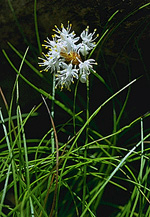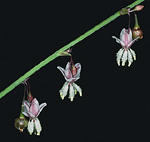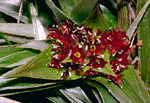 |
This very large and diverse family is often divided into a number of segregate
families but is retained here in its broad sense. It is very widely distributed,
particularly in the temperate regions of both Hemispheres. In Australia,
the greatest number of species occur in the south-east and south-west;
fewer species are tropical, and few occur in the arid region. Most species
are found in open habitats, especially woodlands, grasslands and open
forests. Many introduced species are weeds of disturbed places.
Characteristic features of the family Liliaceae in Australia include: - perennial herbs with sword-shaped, linear or sometimes ovate leaves, usually with parallel veins, most often tufted but sometimes alternate or clustered along aerial stems.
- flowers in racemes, umbels or heads, with 6 usually petal-like perianth segments which may be all similar or in 2 dissimilar whorls of 3 each, fused at the base or free
- stamens 6
- ovary superior, 3-chambered, developing into a capsule or berry containing relatively large, usually black and often angular seeds
Description
Evergreen, deciduous or semi-deciduous shrubs, or woody or herbaceous vines climbing by hooks, twining or scrambling stems, or annual or perennial terrestrial herbs, or aquatic herbs rooted in the substrate with their leaves emergent, perennating by bulbs, corms, rhizomes or crowns. Vegetative reproduction absent or by bulbs, corms, tubers, rhizomes or stolons, or by detached stem parts, bulbils or proliferous flowerheads. Leaves present or ±absent. Stem internodes solid, spongy or pithy or hollow, terete, oval or slightly flattened, strongly flattened or distinctly angular. Internal secretions not obvious or of mucilage. Plants glabrous, or with simple, non-glandular, unicellular or uniseriate hairs. Leaves well developed or much reduced (i.e. to scales, etc), alternate and spiral, or distichous, or rarely whorled or pseudo-whorled, or if herbs then the leaves cauline, all or mostly basal, or both basal and cauline, petiolate, subsessile or sessile. Stipule-like lobes absent. Lamina simple, symmetric, filiform, acicular, subulate, linear, lanceolate, ovate, elliptic, oblong or orbicular; base cuneate, attenuate, or rarely cordate; margins entire, ±flat, revolute, recurved, involute or incurved; venation pinnate, or parallel, with the midrib conspicuous or inconspicuous, and the tertiary venation reticulate or not reticulate; surfaces not punctate; herbaceous, leathery or succulent; distinctive odour absent or aromatic. Leaf ligule absent. All the flowers bisexual, or with male and female flowers occurring on same plant or on separate plants, or bisexual flowers in all possible combinations with either male and/or female flowers on the same plant or different plants. Inflorescences terminal or axillary, consisting of capitula, spikes, racemes, panicles, monochasial cymes, corymbs, umbels or solitary flowers, or apparently of spikelets. Bracts present or absent. Pollination by insects or birds. Flowers odourless or fragrant, sessile or stalked. Floral disc absent; nectaries absent or present on the perianth, the carpels or the stamens. Perianth of 2 dissimilar whorls or of 1 whorl only or all whorls ±similar, with 6 segments, often all petaloid. Calyx regular; segments free or fused, with 3 sepals or lobes, imbricate in bud; calyx cup-shaped, bell-shaped, urn-shaped, funnel-shaped or tubular, herbaceous, papery or membranous. Corolla regular or irregular; segments free or fused, with 3 petals or lobes, alternating with the sepals or calyx lobes, imbricate, valvate or open in bud; corolla wheel-shaped, cup-shaped, bell-shaped, urn-shaped, funnel-shaped or tubular, 1-lipped or curved-tubular, white, cream, yellow, orange, red, pink, magenta, purple, violet, blue or green, without contrasting markings, or streaked, spotted, etc, membranous or papery; claws absent; lobes ±entire or trifid, trilobed or more divided. Fertile stamens 3–4, 6 (or 12), opposite to, or both opposite to and alternating with the sepals or calyx lobes, free or at least partly fused to the corolla, free or at least partly fused with the ovary or style, distinct or fused by their filaments into an open or closed tube, all ±equal. Staminodes present or absent. Anthers dorsifixed or basifixed, versatile or not versatile, opening outwards, sideways or inwards by pores, by short slits or by longitudinal slits, 2-celled; appendages absent or basal. Ovary superior and sessile, or part-inferior, or inferior. Carpels (2–) 3, fused; ovary with 1 or 3–7 locules. Style terminal, single and unbranched, or branched above or from the base. Ovules 1–numerous per locule, stalked; placentation basal, parietal or axile. Fruit dry or fleshy, dehiscent, or rarely schizocarpic or indehiscent; a capsule with irregular, septicidal or loculicidal dehiscence, a schizocarp forming mericarps, or nut-like, or a berry; the perianth on the maturing fruit deciduous or dry and persistent. Disseminule macro-surface featureless or with straight hairs; micro-surface ±smooth, papillate, tuberculate or rugose, cream, yellow, orange, red, blue, green, brown, grey or black, glossy or dull. Seeds 1–numerous per fruit. Aril present or absent. Cotyledons 1. Embryo straight, curved, sharply bent, coiled or round or shapeless.
(Note: this description has been generated from the coded data compiled for the key. Any errors in the key data will be reflected in the descriptions.)
A treatment of the family Liliaceae has been published in:
Flora of Australia 45: 148419.
Australian genera of Liliaceae (as recognised for the Flora of Australia)
* = all species introduced
*Agapanthus
Agrostocrinum
Alania
*Albuca
*Allium
*Alstroemeria
*Amaryllis
Arnocrinum
Arthropodium
*Asparagus
*Asphodelus
Astelia
*Baeometra
Blandfordia
Borya
Bulbine
*Bulbinella
Burchardia
Caesia
Calostemma
Campynema
Chamaescilla
Chlorophytum
*Colchicum
Corynotheca
Crinum
Curculigo
*Cyanella
Dianella
Dichopogon
Drymophila
*Gloriosa
Hensmania
Herpolirion
Hodgsoniola
*Hyacinthoides
*Hymenocallis
Hypoxis
*Ipheion
Iphigenia
Johnsonia
Kuntheria
*Lachenalia
Laxmannia
*Leucojum
*Lilium
Milligania
Molineria
Murchisonia
*Muscari
*Myrsiphyllum
*Narcissus
Neoastelia
*Nothoscordum
*Ornithogalum
Proiphys
*Protasparagus
Schelhammera
*Scilla
Sowerbaea
*Spiloxene
Stawellia
*Sternbergia
Stypandra
Thelionema
Thysanotus
*Trachyandra
Tricoryne
Tripladenia
Wurmbea
*Zephyranthes

|
  |

Alania endlicheri (flowers)
Photo: M.Fagg © ANBG

Arthropodium milleflorum (flowers)
Photo: R.Hotchkiss © ANBG

Astelia psychrocharis (flowers)
Photo: C.Totterdell © ANBG

Astelia psychrocharis (flowers)
Photo: D.Jones © D.Jones

|
 |
|